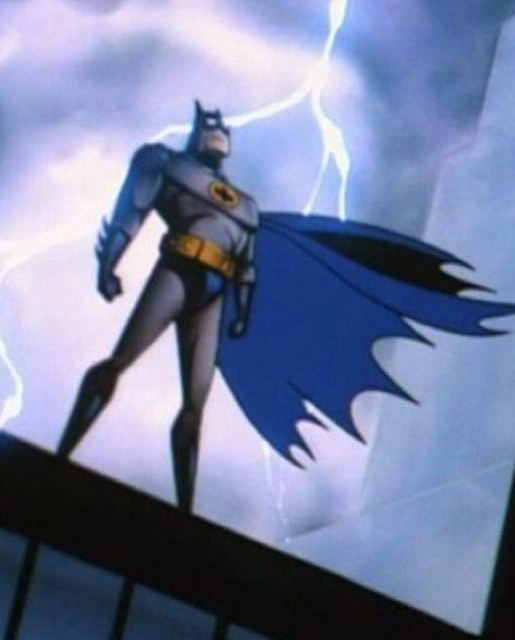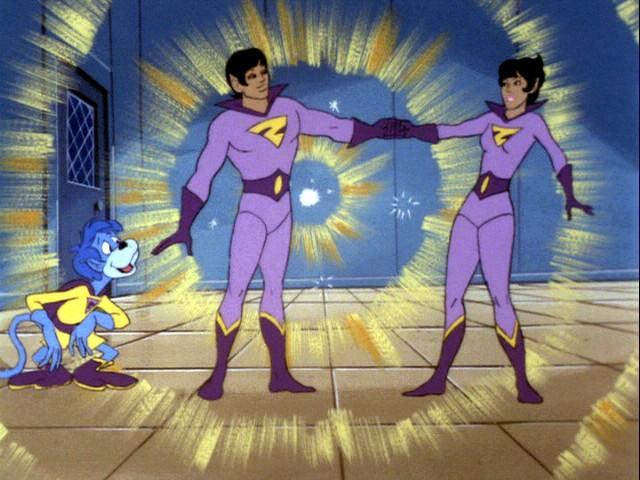 Tim here. During this week’s edition of Hit Me with Your Best Shot, it came as, I assume, no real surprise that my pick came from the animated Batman feature, Mask of the Phantasm. But it’s not just a fixed obsession with animation that led to that choice: it’s my earnest belief that there has never been a better adaptation of Batman in any audio-visual medium than the dark, broody cartoon series that filled in the gap between the theatrical releases of 1992’s Batman Returns and 1995’s Batman Forever. So before we fully leave off our tribute to Batman’s 75th anniversary, I’d like to invite you to join me in a brief appreciation of Batman: The Animated Series.
Tim here. During this week’s edition of Hit Me with Your Best Shot, it came as, I assume, no real surprise that my pick came from the animated Batman feature, Mask of the Phantasm. But it’s not just a fixed obsession with animation that led to that choice: it’s my earnest belief that there has never been a better adaptation of Batman in any audio-visual medium than the dark, broody cartoon series that filled in the gap between the theatrical releases of 1992’s Batman Returns and 1995’s Batman Forever. So before we fully leave off our tribute to Batman’s 75th anniversary, I’d like to invite you to join me in a brief appreciation of Batman: The Animated Series.
That animation would be a good fit for a superhero comic adaptation shouldn’t be surprising on any level, of course: drawings to drawings, rather than drawings to real-world actors, limited by the rules of physics (just think about how much easier it is to make masks look expressive when you’re not bound by things that masks can actually do). And a weekly TV series is more akin to the structure of a monthly comic book, with shorter stories based around more clear-cut scenarios than superhero tend to boast. But there obviously has to be more to it than just that, or I could just as easily make this same argument in favor of The All-New Super Friends Hour, and apologies to the Wonder Twins fans, but no. Just no.

Undoubtedly, Batman had the good fortune to show up at the right time in history: enough years after the beginning of the comics industry’s Dark Age had begun, leading to more moody, serious stories. At the same time, the need to work within the limits of a child-friendly television spot meant that there was a limit on the potential nihilism that has made 21s Century Batman such a dour figure. The result of those two conflicting pressures is a remarkably soulful Batman, not the word one would first think of to describe that character, and yet there it is. Especially thanks to Kevin Conroy’s excellent vocal performance, which lacks the psychological complexity of a Michael Keaton, the bombast of a Christian Bale, or the humor of an Adam West, but manages to (in my opinion) better all of the, by being the most human of Batmans. There are plenty of Dark Knights out there, but Conroy’s take is closer to the Caped Crusader: a passionate, fragile mind driven by a desire to do good, not by a cocktail of bleak psychoses. He is, to me, the Batman it’s easiest to relate to and understand, the Batman who we can care about as a person and not just a summer movie emblem.

That’s a take that’s followed through in the individual stories told by the show, as well. The half-hour format is a forgiving one; it allowed for smaller-scale conflicts than most movies like to stick with, where cities, nations, or gasp The Entire World is at stake if our hero can’t save the day. One of the most celebrated episodes of the animated Batman finds an old TV star (voiced by Adam West, no less) confronting his feelings of obsolescence and age; another gives ultra-hokey gimmick villain Mr. Freeze a backstory so tragic and perfect in its simple domesticity that it was adopted by the comic books.

Even in the more conventionally superheroic stories, the form of the show allowed for more subdued, nuanced conflicts. There is the infamous Joker, voiced perfectly by Mark Hamill, whose relationship to Batman was able to hew far closer to the ideal that comic fanboys always talk about, the nasty-minded embodiment of the id taunting and badgering Batman as something like a hideous parody of a life partner; the movies featuring the Joker, with their need to wrap up his story and make him a one-off villain, haven’t the luxury of doing the same thing.

And of course, there’s the fact that this is the Animated Series. Simply put, this changed the stakes for American television animation: with the background drawings frequently painted on black paper rather than white, to give everything more texture and deeper shadows, it is Western animation’s first overtly Expressionist cartoon, cut with a healthy serving of Art Deco, and set in the hellhole version of major cities that all action movies from the ‘80s took place in.

The only reason it’s not fair to call it the most distinctive cartoon in the history of American television is because it kicked off a host of sanctioned spin-offs and the usual knock-offs. But even better than getting there first, Batman did it best: its creation of an attractively grim underworld just scary enough for afterschool audiences to tolerate it has no equals, and its evocation of the lines and shapes of comic books in moving images gives it visual drama and iconic scale that nothing else adapted from graphic literature has quite matched.